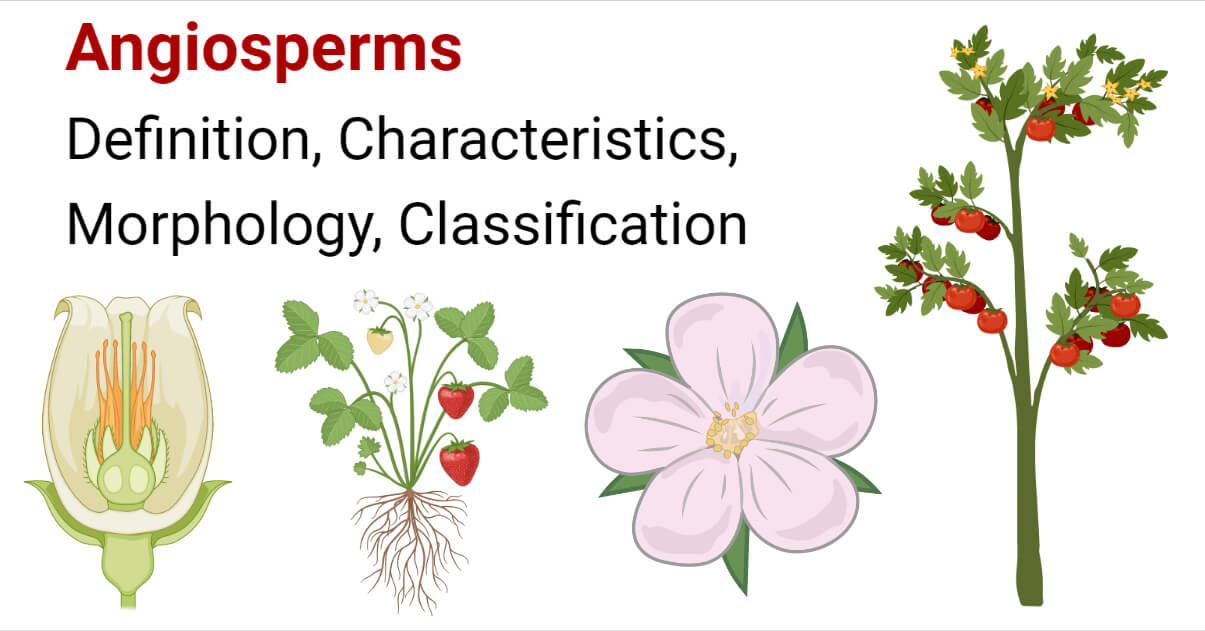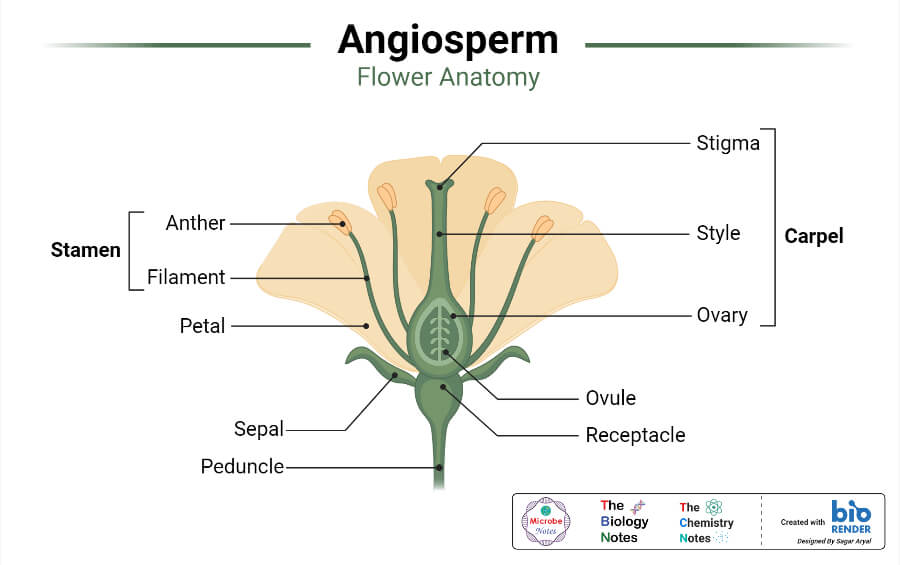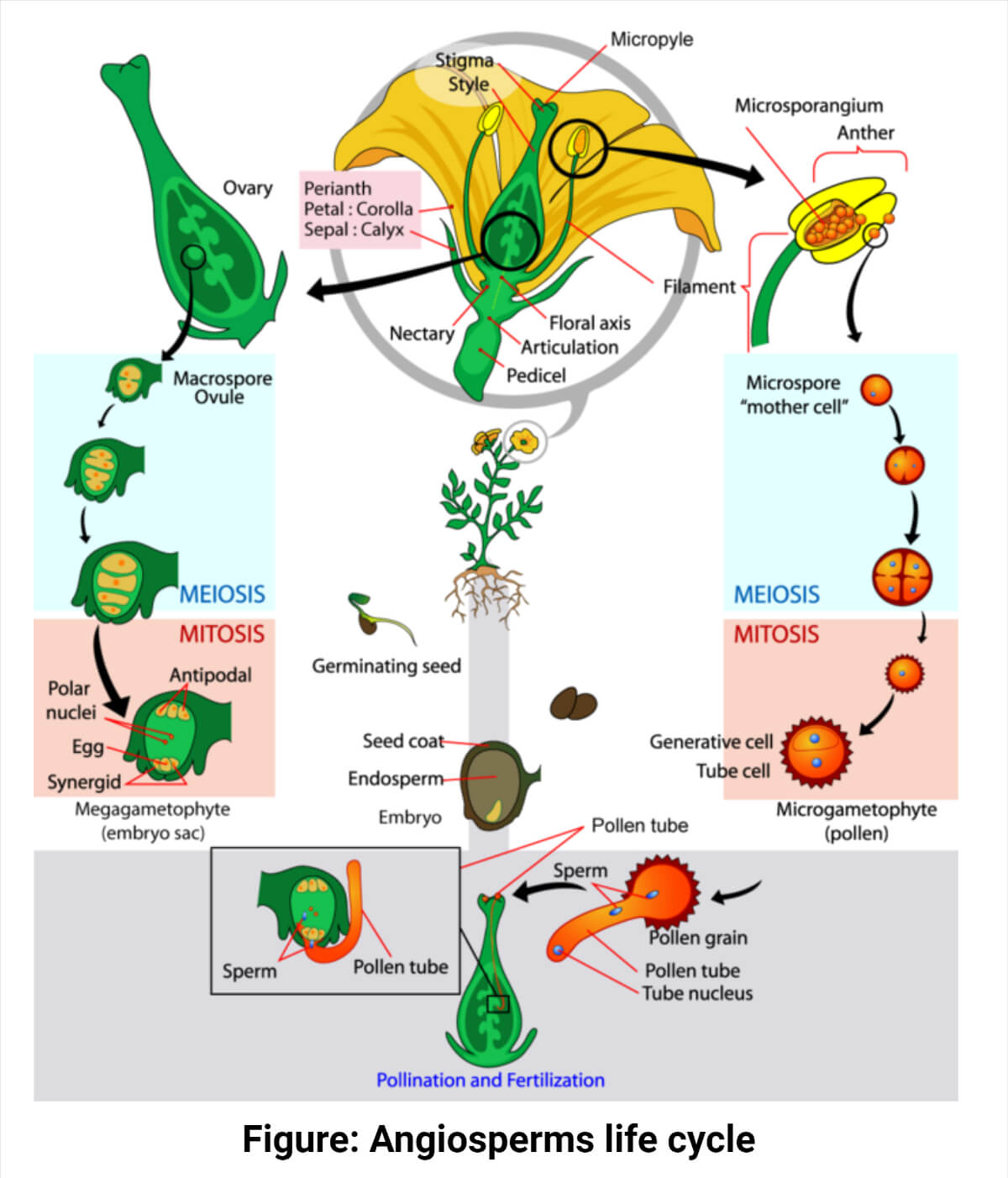Definition: Angiosperms are the plants that produce flowers and vascular plants with leaves, stems, and roots.
- Angiosperms are seed-bearing plants; seeds are developed inside the ovary when the egg or ovule is fertilized.
- Angiosperms are distributed over a large area of ecological habitat and represent about 80% of all known green plants now living.

- They range from tiny (Wolffian, 0.5cm diameter) to tallest angiosperms (Eucalyptus, 120 m height), and the largest angiosperms plant is Ficus bengbalensis which may spread over a large area.
- They can grow in various habitats and are herbs, shrubs, trees, and bushes.
- The term angiosperms are derived from the Greek word ‘angeion’, which means a vessel, and ‘sperma’, which means seed.
- More than 250,000 different species, 8000 genera, and about 453 families of angiosperms are found. It belongs the largest group of kingdom Plantae.
Characteristics of Angiosperms
The main features of angiosperms are as follows:
- Their main plant body is diploid and sporophyte. The sporophyte is divided into stems, leaves, and roots.
- All plants have flowers; flowers are concerned with sexual reproduction that helps in exchanging genetic materials.
- All of the angiosperms are heterotrophs, and a few are autotrophs.
- The vascular system is well developed and consists of xylem and phloem.
- Xylem consists of tracheids and vessels, and phloem consists of companion cells.
- Archegonia are absent.
- Reproduction takes place by indirect pollination, i.e., the pollen grains are received at stigma found at the tip of carpels.
- The flower consists of stamens (microsporophyll) and the carpels megasporophyll); each microsporophyll has four microsporangia.
- The ovules are covered by the ovary at the base of the carpels.
- Double fertilization and triple fusion take place, which leads to the formation of diploid zygotes and triploid endosperms.
- The root system of angiosperms is very complex and consists of the xylem, phloem, cortex, and epidermis.
- Endosperms production is the greatest advantage of angiosperms due to it is a source of food for the developing seed and seeding.
Morphology/ Anatomy of Angiosperms
Angiosperms consist of different four parts flowers, leaves, stems, and roots. Flowers are the reproductive organs, while other body parts are non-sexually reproductive parts.
Generally, angiosperms are divided into two parts root system (which represents the parts of the plant which is located under the soil) and the shoot system (which represents the part of the plant above the soil).
Angiosperms Root system
- It is an underground part of the plant, a brown, non-green part. Primary rot and lateral or branching root are present in the root system.
- Root systems help in the storage, anchorage, and absorption of mineral waters from the soil and provide nutrition all over the body.
- A root that arises from the radicle of the embryo of the seed is called the primary root, and lateral branches are grown from the primary root, called secondary roots.
- The roots have unicellular root hair.
- Generally, the root tip is protected by a thin-like structure called a root cap.
- The origin of lateral roots is endogenous nature.
- The root is positively geotropic but negatively phototropic.
Generally, two types of root systems are seen in angiosperms one is the tap root, and another is the adventitious root.
1. Taproot
- Taproot arises from the radicle of the embryo (germinating seed).
- It is always underground and penetrates very deep into the soil.
- It consists of a prominent root that gives many thin branches; the primary root persists throughout the life of the plant.
- The tap root system is mainly found in dicotyledonous plants such as mangoes, mustard seeds, and banyan.
2. Adventitious root system
- Adventitious root system arises from any part of plants other than the radicle.
- It may be underground, or some are aerial and don’t penetrate the deep soil.
- Clusters of roots are present that may grow from the same point.
- The primary root is short-lived and is soon replaced by adventitious roots.
- This root system is mostly found in monocotyledonous plants such as maize, oak, trees, and horsetails. Functions of adventitious root systems are vegetative propagation and mechanical supports.
- In wheat, carrot, onion, grass, and paddy, fibrous adventitious roots were found. This type of root arises from thin, primary, or moderately branchy root growing from the stem, fibrous adventitious root system found in fern and monocotyledonous.
Angiosperms Shoot system
1. Stems
- The essential part of the plant is the stem. It is an aerial axis in nature.
- Stems bear the flowers, fruits, and leaves.
- The function of the stem is the conduction of minerals and water.
- It is connected to the root system for the continuous flow of nutrients by a transition region known as hypocotyl.
- Steams developed from the plumule of the germinating seeds.
- Generally, young stems’ color is green and becomes woody and brown when it grows into a tree.
- It provides axial stability to plants.
- The terminal bud is present at the apex of the steams.
- In angiosperms, stems are differentiated into nodes (points where the plant bears leaves) and internodes (area between the two nodes).
According to phyllotaxy, we can study the arrangements of leaves on the stems as follows:
- One leaf per node as a spiral arrangement.
- One leaves per node with a divergence of 180 degrees as the alternate arrangement.
- Two leaves per node are opposite arrangement and,
- More than two leaves per node are a whorled arrangement.
- Except for axial stability, the stems of plants undergo certain conditions that undergo modification, such as suckers, runners, climbers, tubers, tendrils, thorns, bulbils, cladode, and rhizomes. That helps in the protection, synthesis of food, vegetative propagation, etc., to keep the plant healthy and growing even with the changing condition.
2. Leaves
- Leaves of the angiosperms are usually flattened and laterally born structures. It is an important part of the plant for photosynthesis, absorbing lights, and the exchange of gases via the stomata.
- The leaf base, petiole, stipules, and lamina, also called a blade, are the main part of a leaf.
- A couple of stipules are found on each turn of the leaf base, but the lamina and the leaf base are linked through the petiole.
- The leaf grows from the node and bears a bud at the axil.
- The leaves are green due to the presence of chlorophyll (which is photosynthetic pigment) and have a tiny pore or opening called stomata.
- Venation is the terms refers to the arrangement of veins and veinlets in a leaf.
- Based on a pattern of leaf lamina, leaves can be further divided into simple and compound leaves, and different other types of classification are done based on the arrangement of leaves, venation, and shape of the leaf.
- There are some essential functions performed by leaves are storage, photosynthesis, transpiration, guttation, and defense.
- The basic structure of the leaf differs from one plant to another plant depending on its functionality and the presence or absence of petiole and stipules. The various structural form of leaves is leaf tendrils, spines, storage leaves, and insect-catching leaves.
3. Flower
- The flowers are the reproductive part of angiosperms. Micro and megaspores are arranged in flowers that may be bisexual or unisexual.
- Flowers are arranged on the floral axis is called inflorescence, which is two types one is Racemose (that lets the main axis continue to grow), and the second is Cymose (that terminates the main axis in a flow).
- They are beautiful, color full, and most of them have a sweet smell. Insects and birds are attracted to the flower due to the smell. Birds and insects play an important role as vectors for the transport of pollen grains from the anther to the stigma of different plants or the same plant. This process is called pollination.
- Pollens, stamens and carpels are main parts of flower.
- The pollen grain is produced by stamens; it is the male gamete (or sperm) that unites with the female gamete ova present in the ovary.
- Carpel is the female part consisting of stigma, style, and ovary, and the stamen is the male part consisting of anther and filament.

Four different whorls are present in the flowers, which are as follows:
- Calyx: it is the outermost part of the flowers.
- Corolla: corolla comprises petals.
- Androecium: it is comprises of stamens.
- Gynoecium: it is composed of one or more carpels.
- The primary function of flowers is reproduction, production of diaspores without fertilization, developing gametophytes, attracting insects and birds for pollination, and developing fruits that contain seeds.
4. Fruits
- A mature ovary develops into fruits containing seeds. The fruits produced without fertilization are known as parthenocarpic.
- Three various types of fruits are known based on the mode of development.
- Simple (developed from the monocarpellary or multicarpellary)
- Aggregate (developed from the multicarpellary) and,
- Composite (developed from the entire inflorescence rather than from a single flower example are blackberries, strawberries, etc.).
- Seeds: seeds are found inside the fruits, made up of an embryo and seed coat. Seeds are classified into two groups depending on the number of cotyledons; monocotyledonous and dicotyledonous.
Classification of Angiosperms
Angiosperms are classified into two classes based on cotyledons present in seeds.
1. Monocotyledons
- The seeds contain a single cotyledon.
- This group has adventitious roots only. Roots contain 8 to 20 vascular bundles. In a stem, vascular bundles are scattered.
- Secondary growth is absent because vascular bundles of stems lack cambium.
- The leaves are isobilateral, simple, usually linear, and contain parallel venation.
- Each flowers whorl is usually trimerous or has three members.
- Usually, calyx and corolla are undifferentiated. The perianth is present instead of them,
- Usually, they are pollinated by wind.
- Generally, fruits are trilocular.
- Examples: sugarcane, banana, lilies, etc.
2. Dicotyledons
- The seeds of dicotyledons contain two cotyledons.
- Usually, they have tap roots, but in some cases, adventitious roots are also present.
- The root contains 2 to 6 vascular bundles.
- Stems vascular bundles are arranged in a ring.
- Secondary growth is possible because of cambium present in vascular bundles of stems.
- The leaves are dorso-ventrally flattened, depict, and have reticulate venation.
- Flowers are usually tetramerous or pentamerous.
- Usually, calyx and corolla are distinct.
- They usually are pollinated by insects.
- Fruits are usually pentalocular.
- Examples: grapes, sunflowers, tomatoes, etc.
Read Also: Monocots vs Dicots- Definition, 26 Differences, Examples
Evolution of Angiosperms
- The fossil record indicates that angiosperms originated about 125 million years ago during the late cretaceous period.
- Angiosperms are ascribed from the pollen fossils recovered from the geological material from the Jurassic periods and the imprints of leaves found on the fossils present in cretaceous rocks.
- To understand the evolution of angiosperms there are several hypotheses have been developed, but paleontologists are facing various challenges while studying the evolution and clarifying the origin and diversification of angiosperms.
- Some botanists believed angiosperms originated from gymnosperms; however; still, they form their distinct species.
- During the late Mesozoic era, angiosperms form a sister clade rather than derived from angiosperms, clade developed in parallel with the angiosperms.
- The earliest living flowering plant is said to be Amborellatrichopoda, which is the oldest branch of angiosperms.
- In the initial angiosperms, there is variation in structure, flower size, or organization, but there is consistency in flower diversity concerning radiation of angiosperms and diversification of the floral forms.
Life cycle and reproduction of Angiosperms
- Flowers are the reproductive organ in angiosperms.
- The sexual reproduction process depends upon pollination to bring these gametophytes into a close association so that fertilization can take place.
- All plants undergo alternation of generation and alternation between haploid gametophyte and diploid sporophyte’s life stages.

- Sporophytes are the main phase of the life cycle of angiosperms.
- Angiosperms are heterosporous and produce microspores that will form pollen grain (male gamete) and megaspores that will produce female gametophyte ovule.
- Inside the anther, microsporangium is present. These microsporangia undergo meiosis division and generate haploid microspores, and again microspores undergo mitosis division and produce pollen grains. Each pollen grains have two cells: one generative cell, which is divided into two sperm cell, and a second cell which is developed into the pollen tube cells.
- Inside the ovule, megasporangia are presently surrounded by integument and the ovary wall, Megasporocytes produce four megaspores through meiosis (three small and one large), and only large megaspores are retained and produce embryo sac.
- One egg cell, three antipodal cells, two synergids, and two polar nuclei are present in the mature embryo sac.
- When the pollen grain migrates and reaches the stigma, it enters the stigma, and the pollen cell extends from the pollen grain down the style to form the pollen tube. The generating cells divide mitotically to form two sperm nuclei. These are deposited into the embryo sac.
- A double fertilization process then occurs. Once the sperm nucleus fertilizes the haploid egg creating the diploid zygote, the future embryo and the other sperm fertilize with the polar nuclei (2n), forming a triploid (endosperms).
- The diploid seed coat hardens, and the endosperms tissue serves as a food source for the embryo while the seed is dormant.
- After germination, when the seed coat breaks to expose the sporophyte, the sporophyte grows and matures into the flowering plant, and the cycle repeats.
Uses and Applications of Angiosperms
- Angiosperms serve as an important source of food for animals, humans, and living organisms. That contains an abundant amount of carbohydrates, proteins, fat, and nutrients.
- For the ecological web and food chain, angiosperms are very important.
- Carbohydrate contains a compound that is important to synthesize the cellular structure of plants and provide the nutritional need and their metabolism.
- The vegetative part of the angiosperm plants is consumed by different types of insects and invertebrates, and foods or seeds are an energy source for animals.
- The life cycle or reproductive cycle of many animals like birds, bats, and mammal depends on the energy they synthesize after consuming fruits available on the angiosperms.
- Angiosperms protect many plants from foreign invasion or herbivorous via producing toxic secondary compounds such as oils, alkaloids, and glycosides.
- Many medicines are synthesized from angiosperms, so they play a vital role in pharmaceuticals. Vitamins, aspirin, narcotics, and quinine are formulated from angiosperms.
- Some compounds of angiosperms are used for the treatment of disease, quinine is used to treat malaria, and leukemia is treated by using Vincristine.
- Animals and humans habited depend on food resources and oxygen supply so, it maintaining human, animals, birds, and insect habitats.
- Tropical angiosperms trees are used as a source of timber.
- Woody plants are used to make furniture.
- Water-repellent fiber extracted from kapok fruits is used in sound and thermal insulation, an oil used for cooking, lubricant, and preparation of soap.
- Corn, wheat, barley, oats, sorghum, rice, and ray members of the family Poaceae are economically the most important grains throughout the world.
- Grapes, barley, wheat, etc. are used in the alcoholic beverage production industry.
- Corn oil and cornstarch are used in manufacturing cosmetic products, adhesives, varnishes, paints, soap, and linoleum.
- Some seeds contain an abundant amount of proteins and oil (peanuts, soybean), which are most beneficial for farmers to build up their economic condition.
- Coffea (derived from Coffea arabica) and tea (derived from Camellia sinensis), and many soft drinks derived from the angiosperms.
- Flowers are used for decoration, and angiosperms also contribute to biodiversity.
Angiosperms Examples
- Rice (Oryza)
- Corn (Zea mays)
- Wheat (Triticum)
- Lilies (Lilium)
- Tomato (Solanum lycopersicum)
- Sunflowers (Helianthus annuus)
References
- Panday, B.P.(2005). A Textbook of Botany, Angiosperms: Taxonomy, Anatomy, Embryology (Including Tissue Culture) and Economic Botany. S. Chand and Company LTD, Ram Nagar, New Delhi.
- Eames, A. J. (1961). Morphology of the angiosperms. Morphology of the angiosperms., (1st Ed).
- Soltis, D. E., Bell, C. D., Kim, S., & Soltis, P. S. (2008). Origin and early evolution of angiosperms. Annals of the New York Academy of Sciences, 1133(1), 3-25.
- Keshari, A.K., Ghimire, K.R., Mishra, B.S. and Adhikari, K.K.(2018). A Textbook of Higher Secondary Biology, XII. Vidhyarthi Pustak Bhander, Kamalpokhari/Bhotahiti, Kathmandu, Nepal.
- https://bio.libretexts.org/Bookshelves/Introductory_and_General_Biology/Book%3A_General_Biology_(Boundless)/26%3A_Seed_Plants/26.03%3A_Angiosperms/26.3C%3A_The_Life_Cycle_of_an_Angiosperm.
- https://www.britannica.com/plant/angiosperm.
- https://byjus.com/biology/angiosperms.
- https://www.biologyonline.com/dictionary/angiosperm.
- https://bio.libretexts.org/Bookshelves/Introductory_and_General_Biology/Book%3A_General_Biology_(Boundless)/26%3A_Seed_Plants/26.01%3A_Evolution_of_Seed_Plants/26.1C%3A__Evolution_of_Angiosperms
- https://www.britannica.com/plant/angiosperm/Significance-to-humans.
